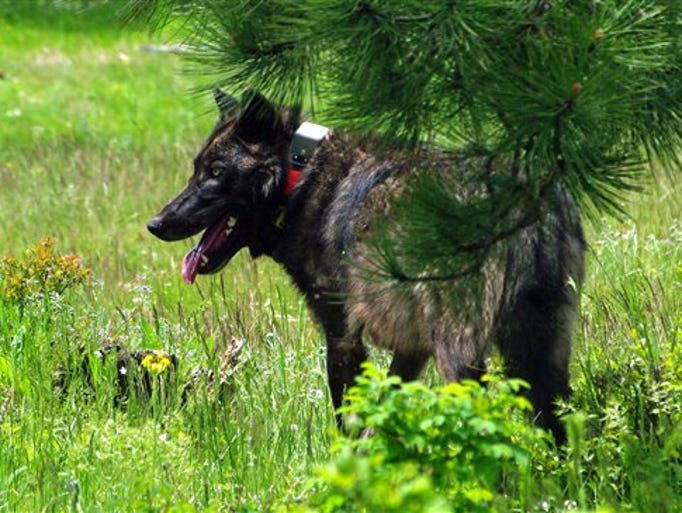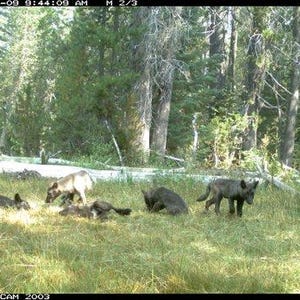The meeting has been described as a showdown over the very future of gray wolves in Oregon.
Busloads of ranchers, hunters and environmentalists are expected to converge in Salem on Monday for the Oregon Fish and Wildlife Commission meeting that will result in a decision on whether to remove canis lupus from state Endangered Species Act protection.
The meeting, which begins at 8 a.m., is likely to have a full day of impassioned public testimony centering on the question of whether Oregon’s 83 known wolves represent a stable, healthy and recovered population.
Yet lost within the noise is a reality not widely understood: The decision by the commission will have almost zero impact on how wolves are managed.
While the Oregon Endangered Species Act sounds important, it’s more of a relic from a time before wolves returned to Oregon. It carries little impact on decisions regarding how the state treats its wolf population.
If wolves are delisted — as most people expect — it will remain illegal to kill them in the western two-thirds of the state. In Northeast Oregon, ranchers would only be allowed to shoot a wolf caught in the act of wounding, biting, killing or chasing livestock, as is currently the case. Non-lethal deterrence measures would remain the first choice for resolving wolf-related conflict. Delisting could open the door for hunting wolves in certain circumstances, if approved by the commission, but not for many years.
“Wolf management in Oregon is guided by the Wolf Plan and its associated rules, not the Oregon Endangered Species Act,” said Russ Morgan, wolf program manager for ODFW. “Delisting wolves would result in no immediate changes to wolf management.”
Given that, why are pro-wolf groups predicting doom and hinting at legal action to keep wolves listed? Why are ranchers and hunters so eager to get wolves delisted?
It helps to start at the beginning.
How did we get here?
Wolves' place on the Oregon Endangered Species Act is, in many ways, a relic from a time before the animals had returned to Oregon.
When the Oregon Legislature enacted the law in 1987, it grandfathered in all species native to Oregon — including wolves — that were then listed under the federal ESA.
As wolves began arriving in Oregon in the late 1990s and early 2000s, the Wolf Conservation and Management Plan was created to manage them. The plan is reviewed every five years and the document holds sway in decisions regarding wolves.
According to the plan, ODFW can consider delisting wolves when four breeding pairs are present in Eastern Oregon for three consecutive years. That criterion was met in January 2015. By law, ODFW undertook a status review that looked at the health of wolves in Oregon.
Where the fighting starts
The number of wolves in Oregon has gradually increased, from 14 in 2009 to around 83 today. Most observers believe the actual number is higher, around 100 to 130, since ODFW can’t track every wolf in the forest.
To delist, as called for in the wolf plan, ODFW had to demonstrate that wolves were not in danger of extinction or a major population failure.
In a report released this summer, the agency said that most factors pointed toward a healthy and growing population.
Wolf habitat in Oregon is stable and wolf range expanding, the agency said, pointing to the expansion of wolves into Western Oregon and even Northern California. Given protections under the wolf plan, no major uptick in wolf killing would be legal.
Environmental groups disagree with this assessment. They say the wolf population remains fragile and delisting is premature. They have also taken issue with ODFW’s methodology, saying the agency broke the law by failing to consult independent biologists outside the agency.
They have hinted that should the commission vote to delist, litigation could follow.
“If they vote to delist, we certainly have some concerns that the state is out of accordance with the law,” said Arran Robertson, communications direction for Oregon Wild. “We’ve been trying to get them to consider the independent science in making this decision, and we’re trying to avoid litigation, but we’ll have to wait until Monday to see what happens.”
Perhaps the biggest consequence of delisting wolves, according to both environmentalists and ranchers, is that it removes a potential tool for litigation.
Environmental groups couldn’t use the Oregon ESA to file a lawsuit if wolves were not covered.
“The ESA forces the agency to give us more accountability, more transparency,” Robertson said. “We lose a tool to keep state accountable in developing the next phase of the wolf plan.”
Enterprise cattle rancher Todd Nash, who works with the Oregon Cattlemen’s Association, had a similar view but different takeaway.
“The environmental groups want to use the ESA for litigation — not based on the wolf plan or what’s actually happening on the ground — but to further their own interests,” Nash said. “They had people at the table who signed off on the wolf plan. It’s working. Wolves have spread all over the state. But it’s still not enough for them.
“They create this endless loop of lawsuits, based on the need to fundraise, that is really dishonest.”
Environmental groups have also said that removing wolves from the list would give people the idea that killing wolves was acceptable and would reduce penalties for poaching.
"Our main concern is the message it sends, that people will take it the wrong way and we'll see more people going out and shooting wolves," said Nick Cady, legal director for Eugene-based Cascadia Wildlands, in an interview earlier this year.
In the end, beyond the theoretical realm of lawsuits and symbolic importance of being listed, there’s only one potential consequence that actually comes from wolves being delisted.
In the future, once wolves reached Phase III of the wolf plan, the commission could choose to allow a controlled take — tightly regulated hunting for wolves — in situations of chronic livestock depredation or wolf-related declines in prey populations. That would be a long way off.
Whether or not the commission decides to delist on Monday, little will change in wild places of Oregon where wolves currently roam.
Zach Urness has been an outdoors writer, photographer and videographer in Oregon for eight years. He is the author of the book “Hiking Southern Oregon” and can be reached at zurness@StatesmanJournal.com or
About the meeting
What: Oregon Fish and Wildlife Commission meeting to determine whether to remove gray wolves from the protection provided by the Oregon Endangered Species Act
When: 8 a.m. Monday
Where: ODFW headquarters, 4034 Fairview Industrial Drive SE, Salem
Public comment: Arrive early to sign up to give public comment
source






No comments:
Post a Comment